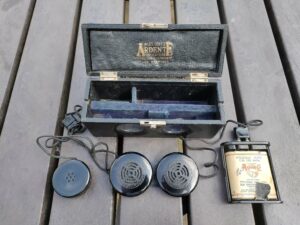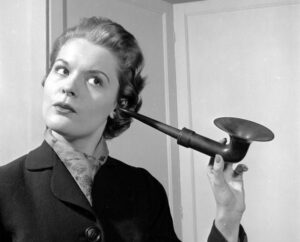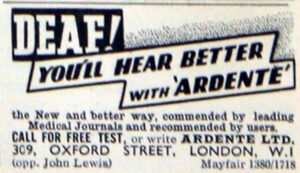Objects from our Store – Ardente Hearing Aid
By Steve Crane
On our next dive into the depths of the Museum’s store rooms, we’ll be taking a look at one of the earliest types of electrical hearing aid. While crude by the standards of modern aids, it nonetheless represented a major advance over anything that had been previously available.

The unit has three main components, all connected by electric cables and sockets:
- A pair of microphones, which are fixed together (centre of picture)
- An earphone (left)
- A battery pack (right)
The microphone unit has a clip on the back so that it could be attached to one’s clothing, for example, the breast pocket of a jacket. Alternatively, it could be placed in the box behind the circular cutouts, which would be more useful if the sound source was fixed, like a radio. There is also a volume control switch on the back.
The earphone is on a fairly long lead, and could be swapped with an earpiece which would plug into the user’s ear: unfortunately, this is missing from our set.
The battery pack contains four ‘AA’ batteries (note that this size was standardised in 1907!), giving a total of 6 volts. Batteries needed to be replaced frequently.
All this is stored in a wooden box with a hinged lid, covered in black leatherette, and measuring around 20cm (8 inches) wide, 8cm (3¼ inches) tall and 7cm (2¾ inches) deep – portable but hardly inconspicuous!
In the days before the NHS, the high price of these hearing aids would have restricted their use to a limited number of better-off people: the typical price of £25 in 1944 compares to an average workman’s income of around £4 a week
Brief History of Hearing Aids
People have suffered from hearing loss since time immemorial, but practical hearing aids have only been available for the last 100 years or so. Ear trumpets were introduced in the 17th century, made of wood, metal or natural objects such as shells and animal horns, but they were not very effective.

The invention of the microphone and telephone in the late 19th century provided technology which could capture, amplify and transmit sounds, leading to the production of the first electric hearing aid in 1898. Early microphones contained tiny carbon balls, giving only limited amplification, and multiple microphones (as in our set) were needed to boost the sound. In the 1920s, valves (glass vacuum tubes) offered much greater amplification, but were fragile, bulky and needed larger batteries, so were not widely adopted. Carbon microphone hearing aids continued to be used into the 1950s. The first commercial application for transistors was for hearing aids in 1952 (before their use in radios), and further developments in microelectronics and battery technology have resulted in modern aids small enough to fit behind or inside the ear.
The Ardente Company
Reuben Henry Dent founded the Ardente company (a play on his name) in 1919. An immigrant from Lithuania, he began by importing German hearing aids before manufacturing his own range. Ardente seems to have been a very popular brand, adopting modern technology and continuing production until Mr Dent’s death in 1962.

